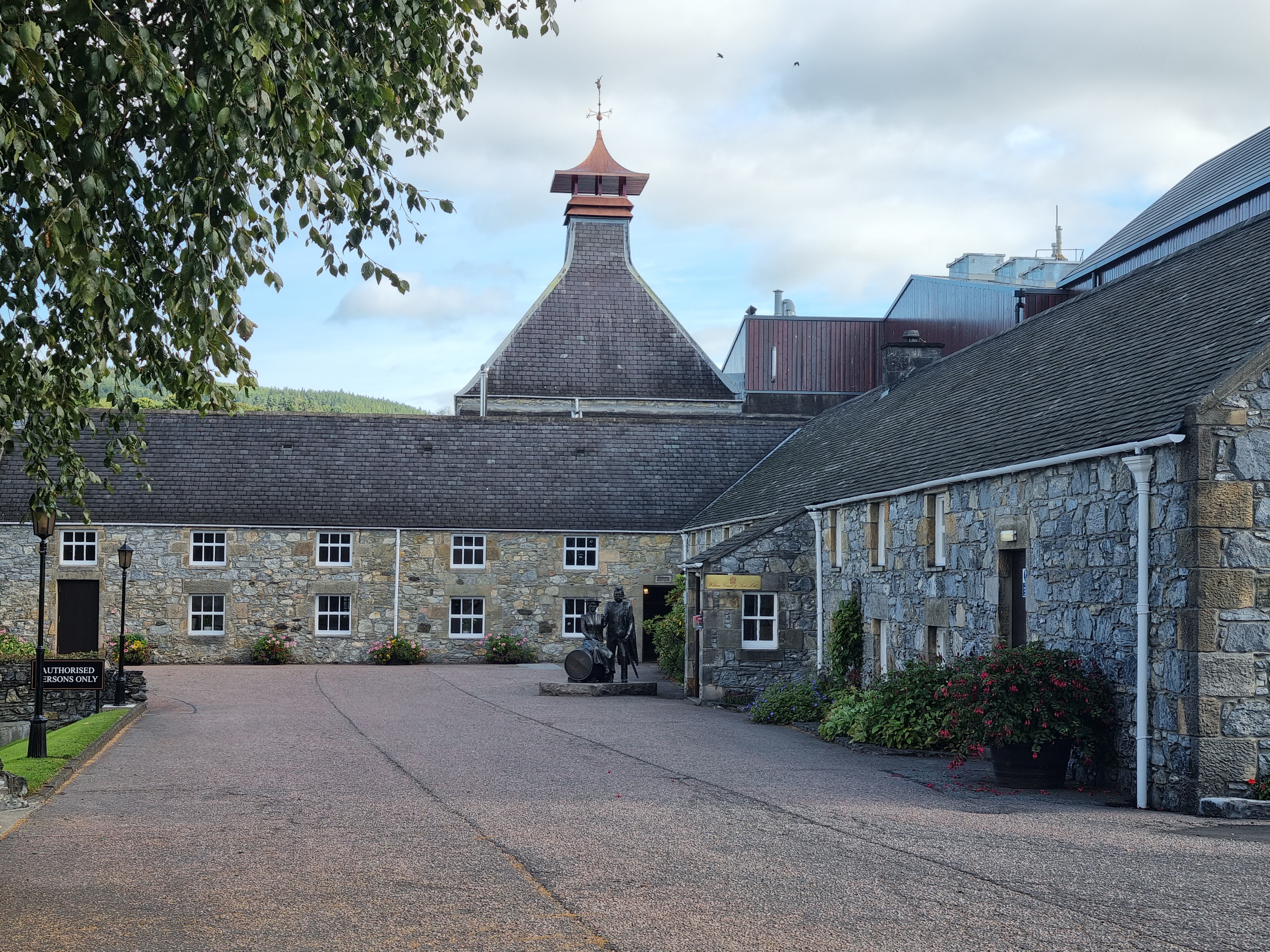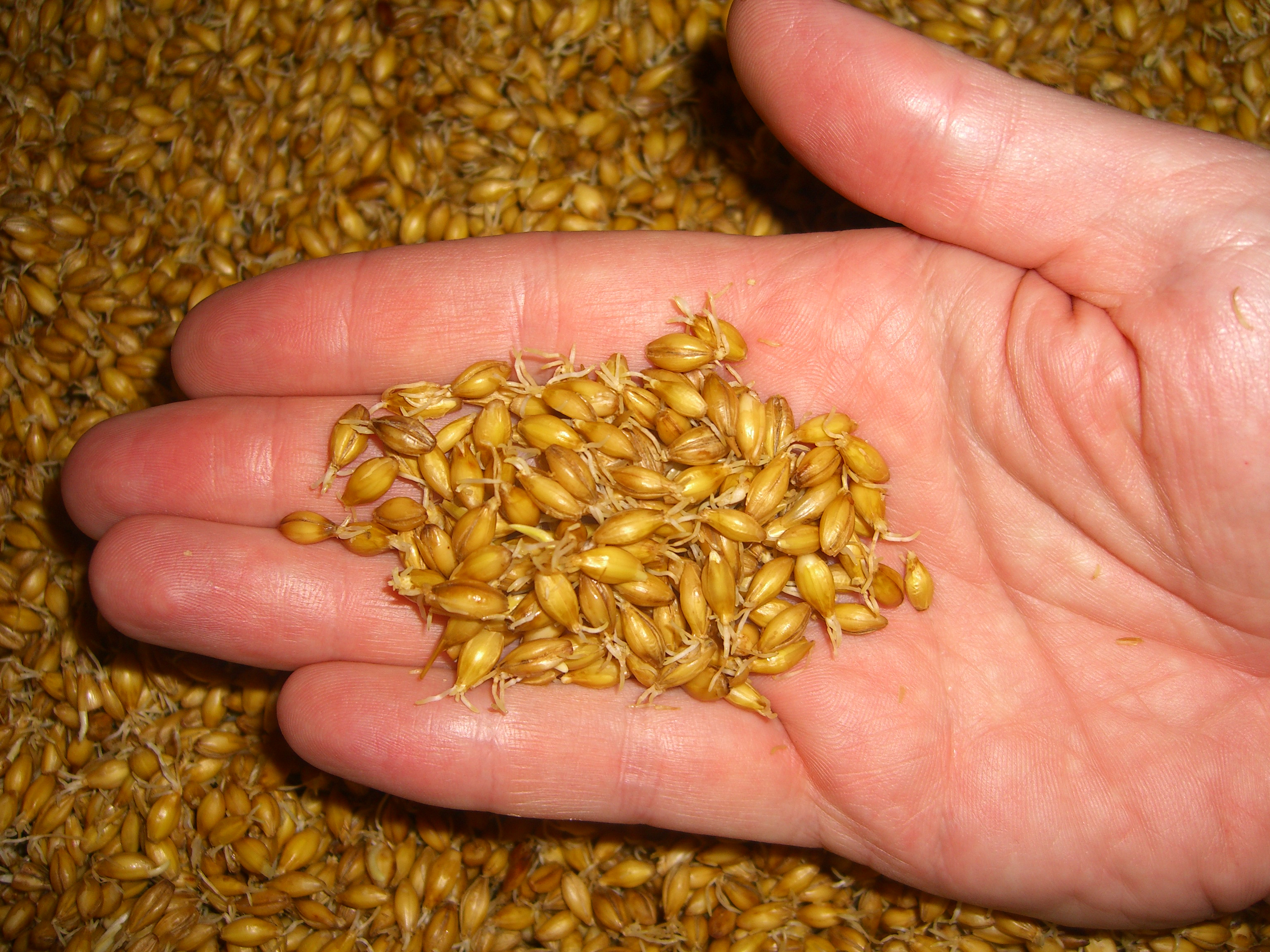|
Monkey Shoulder
Monkey Shoulder is a brand of Scotch whisky produced by William Grant & Sons in Scotland. Monkey Shoulder is a blended malt whisky, one of a small number of whiskies in this style. As of 2023, Monkey Shoulder is the world's third best-selling brand of Scotch whisky, trailing Johnnie Walker and The Macallan. History Monkey Shoulder was introduced in 2003 as a brand of blended malt whisky (formerly called "vatted malt whisky") primarily for mixing, occupying a middle ground between blended Scotch (which can contain grain whisky) and single malt whisky (which cannot). Originally a blend from the Balvenie, Glenfiddich, and Kininvie distilleries, its current composition is not publicly known, although its constituent malt whiskies originate from the Speyside region. The name refers to a repetitive strain injury that distillery workers once commonly were afflicted with after long shifts of turning malt Malt is germinated cereal grain that has been dried in a process ... [...More Info...] [...Related Items...] OR: [Wikipedia] [Google] [Baidu] |
Scotch Whisky
Scotch whisky (; sco, Scots whisky/whiskie, whusk(e)y; often simply called whisky or Scotch) is malt whisky or grain whisky (or a blend of the two), made in Scotland. All Scotch whisky was originally made from malted barley. Commercial distilleries began introducing whisky made from wheat and rye in the late 18th century. , there were 141 whisky distilleries operating in Scotland. All Scotch whisky must be aged immediately after distillation in oak barrels for at least three years. Any age statement on a bottle of Scotch whisky, expressed in numerical form, must reflect the age of the youngest whisky used to produce that product. A whisky with an age statement is known as guaranteed-age whisky. A whisky without an age statement is known as a no age statement (NAS) whisky, the only guarantee being that all whisky contained in that bottle is at least three years old. The minimum bottling strength according to the regulation is 40% alcohol by volume. Scotch whisky is divided in ... [...More Info...] [...Related Items...] OR: [Wikipedia] [Google] [Baidu] |
Glenfiddich Distillery
Glenfiddich distillery () is a Speyside single malt Scotch whisky distillery owned by William Grant & Sons in the Scottish burgh of Dufftown in Moray. The name Glenfiddich derives from the Scottish Gaelic ''Gleann Fhiodhaich'' meaning "valley of the deer", which is reflected in Glenfiddich's stag logo. History The Glenfiddich Distillery was founded in 1886 by William Grant in Dufftown, Scotland, in the glen of the River Fiddich. The Glenfiddich single malt whisky first ran from the stills on Christmas Day, 1887. In the 1920s, with prohibition in force in the US, Glenfiddich was one of a very small number of distilleries to increase production. This put them in a strong position to meet the sudden rise in demand for fine aged whiskies that came with the repeal of prohibition. In the 1950s, the Grant family built up an onsite infrastructure that included coppersmiths to maintain the copper stills, and a dedicated cooperage that is now one of the very few remaining in distiller ... [...More Info...] [...Related Items...] OR: [Wikipedia] [Google] [Baidu] |
Scottish Brands
Scottish usually refers to something of, from, or related to Scotland, including: *Scottish Gaelic, a Celtic Goidelic language of the Indo-European language family native to Scotland *Scottish English *Scottish national identity, the Scottish identity and common culture *Scottish people, a nation and ethnic group native to Scotland *Scots language, a West Germanic language spoken in lowland Scotland *Symphony No. 3 (Mendelssohn), a symphony by Felix Mendelssohn known as ''the Scottish'' See also *Scotch (other) *Scotland (other) *Scots (other) *Scottian (other) *Schottische The schottische is a partnered country dance that apparently originated in Bohemia. It was popular in Victorian era ballrooms as a part of the Bohemian folk-dance craze and left its traces in folk music of countries such as Argentina ("chotis"Span ... * {{disambiguation Language and nationality disambiguation pages ca:Escocès ... [...More Info...] [...Related Items...] OR: [Wikipedia] [Google] [Baidu] |
2003 Introductions
3 (three) is a number, numeral and digit. It is the natural number following 2 and preceding 4, and is the smallest odd prime number and the only prime preceding a square number. It has religious or cultural significance in many societies. Evolution of the Arabic digit The use of three lines to denote the number 3 occurred in many writing systems, including some (like Roman and Chinese numerals) that are still in use. That was also the original representation of 3 in the Brahmic (Indian) numerical notation, its earliest forms aligned vertically. However, during the Gupta Empire the sign was modified by the addition of a curve on each line. The Nāgarī script rotated the lines clockwise, so they appeared horizontally, and ended each line with a short downward stroke on the right. In cursive script, the three strokes were eventually connected to form a glyph resembling a with an additional stroke at the bottom: ३. The Indian digits spread to the Caliphate in the 9th ... [...More Info...] [...Related Items...] OR: [Wikipedia] [Google] [Baidu] |
Malt
Malt is germinated cereal grain that has been dried in a process known as " malting". The grain is made to germinate by soaking in water and is then halted from germinating further by drying with hot air. Malted grain is used to make beer, whisky, malted milk, malt vinegar, confections such as Maltesers and Whoppers, flavored drinks such as Horlicks, Ovaltine, and Milo, and some baked goods, such as malt loaf, bagels, and Rich Tea biscuits. Malted grain that has been ground into a coarse meal is known as "sweet meal". Malting grain develops the enzymes (α-amylase, β-amylase) required for modifying the grains' starches into various types of sugar, including monosaccharide glucose, disaccharide maltose, trisaccharide maltotriose, and higher sugars called maltodextrines. It also develops other enzymes, such as proteases, that break down the proteins in the grain into forms that can be used by yeast. The point at which the malting process is stopped affects the starch-to-enz ... [...More Info...] [...Related Items...] OR: [Wikipedia] [Google] [Baidu] |
Repetitive Strain Injury
A repetitive strain injury (RSI) is an injury to part of the musculoskeletal or nervous system caused by repetitive use, vibrations, compression or long periods in a fixed position. Other common names include repetitive stress disorders, cumulative trauma disorders (CTDs), and overuse syndrome. Signs and symptoms Some examples of symptoms experienced by patients with RSI are aching, pulsing pain, tingling and extremity weakness, initially presenting with intermittent discomfort and then with a higher degree of frequency. Definition Repetitive strain injury (RSI) and associative trauma orders are umbrella terms used to refer to several discrete conditions that can be associated with repetitive tasks, forceful exertions, vibrations, mechanical compression, sustained or awkward positions, or repetitive eccentric contractions. The exact terminology is controversial, but the terms now used by the United States Department of Labor and the National Institute of Occupational Safe ... [...More Info...] [...Related Items...] OR: [Wikipedia] [Google] [Baidu] |
Speyside Single Malt
Speyside single malts are single malt Scotch whiskies, distilled in Strathspey, the area around the River Spey in Moray and Badenoch and Strathspey, in northeastern Scotland. The two best-selling single malt whiskies in the world, The Glenlivet and Glenfiddich, come from Speyside. Strathspey has the greatest number of distilleries of any of the whisky-producing areas of Scotland. Dufftown alone has six working distilleries with an annual capacity of 40.4 million litres of spirit. Legal status Speyside is a "protected region" for Scotch Whisky distilling under UK Government legislation. According to ''Visit Scotland'', this region includes the area between the Highlands to the west, Aberdeenshire in the east and extending north to the Cairngorms National Park. Distilleries Illicit distilleries were common in the 1800s, but eventually, licences became available after the passing of th1823 Excise Act George Smith was the first licensee in Speyside, in 1824, and his smal ... [...More Info...] [...Related Items...] OR: [Wikipedia] [Google] [Baidu] |
Kininvie Distillery
Kininvie distillery located in Dufftown, Moray, Scotland produces Single malt Scotch, single malt Scotch whisky. The distillery is owned by William Grant & Sons and the product from the distillery is used in their blended malt and blended whiskey, blended whisky brands. History The Kininvie Distillery began production on 4 July 1990. The distillery was built on the grounds of the Balvenie distillery, and consisted only of a still house. Whilst featuring computer-controlled distillation, it lacks its own Mashing, mash house. Mash houses are responsible for producing the liquid needed for fermentation in the washbacks, so the liquid used by the Kininvie Distillery in their washbacks was piped from the Balvenie distillery some 200 metres away. Kininvie does, however, have its own dedicated mash tun and washbacks on the Balvenie premises, as well as having its own barley specifications. The distillery operated 24 hours a day, 7 days a week to meet demand. The output from the ... [...More Info...] [...Related Items...] OR: [Wikipedia] [Google] [Baidu] |
Balvenie Distillery
The Balvenie distillery is a Speyside single malt Scotch whisky distillery in Dufftown, Scotland, owned by William Grant & Sons. History William Grant was born on 19 December 1839 in his father's house in Dufftown. At seven he began herding cattle at a farm on the upper reaches of the River Deveron. He was apprenticed to a shoemaker then worked as a clerk, and then became a bookkeeper at Mortlach distillery 1866. There he was appointed as a clerk and then manager and learned the distilling trade. After about twenty years, Grant left his job at the Mortlach distillery and bought a field near Balvenie Castle. He then drew up plans for his distillery, and the foundation stone was laid in the autumn of 1886. Grant remained active in the company until his death in 1923 at the age of 83. In early 1892 work began to convert an 18th-century mansion (Balvenie New House) into a distillery. The building took fifteen months to complete, and on 1 May 1893, the first distillation took ... [...More Info...] [...Related Items...] OR: [Wikipedia] [Google] [Baidu] |
William Grant & Sons
William Grant & Sons Ltd is an independent, family-owned Scottish company that distills Scotch whisky and other selected categories of spirits. It was established in 1887 by William Grant, and is run by Grant's descendants as of 2018. It is the largest of the handful of Scotch whisky distillers remaining in family ownership. The company is the third largest producer of Scotch whisky (8% market share), shipping about 7.6 million cases per year, with brands including Glenfiddich and Balvenie. The first and second largest, respectively, are Diageo (34.4%), and Pernod Ricard. The company is registered at The Glenfiddich distillery in Dufftown. The main operational headquarters are located at Strathclyde Business Park, North Lanarkshire. Sales and marketing headquarters are in Richmond, London. The company is a member of the Scotch Whisky Association. The master blender of Grant's is Brian Kinsman, who succeeded David Stewart who had been in his post for 47 years, the longest ... [...More Info...] [...Related Items...] OR: [Wikipedia] [Google] [Baidu] |
Single Malt Whisky
Single malt whisky is malt whisky from a single distillery. Single malts are typically associated with single malt Scotch, though they are also produced in various other countries. Under the United Kingdom's Scotch Whisky Regulations, a "Single Malt Scotch Whisky" must be made exclusively from malted barley (although the addition of E150A caramel colouring is allowed), must be distilled using pot stills at a single distillery, and must be aged for at least three years in oak casks of a capacity not exceeding .The Scotch Whisky Regulations 2009 ''The National Archives'', 2009. ... [...More Info...] [...Related Items...] OR: [Wikipedia] [Google] [Baidu] |



